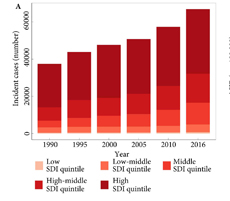
Editorial: Non‐invasive diagnosis and monitoring of urothelial bladder cancer: are we there yet?
In this issue of BJUI, Ward et al. [1] describe the development of DNA‐based urinary biomarkers for urothelial carcinoma (UC). The genomics of UC have been well characterized through interrogation of tumour issues in institutional series (e.g. the Memorial Sloan Kettering Cancer Center [MSKCC] experience), multi‐institutional collaborations (e.g. The Cancer Genome Atlas [TCGA]) and commercial platforms (e.g. the Foundation Medicine experience) [2]. Until recently, these have been largely academic…

Video: Targeted deep sequencing of urothelial bladder cancers and associated urinary DNA
Targeted deep sequencing of urothelial bladder cancers and associated urinary DNA: a 23‐gene panel with utility for non‐invasive diagnosis and risk stratification
Abstract
Objectives
To develop a focused panel of somatic mutations (SMs) present in the majority of urothelial bladder cancers (UBCs), to investigate the diagnostic and prognostic utility of this panel, and to compare the identification of SMs in urinary cell‐pellet (cp) DNA and cell‐free (cf) DNA as part of the…

Article of the week: A longitudinal analysis of urological chronic pelvic pain syndrome flares in the Multidisciplinary Approach to the Study of Chronic Pelvic Pain (MAPP) Research Network
Every week, the Editor-in-Chief selects an Article of the Week from the current issue of BJUI. The abstract is reproduced below and you can click on the button to read the full article, which is freely available to all readers for at least 30 days from the time of this post.
In addition to the article itself, there is an editorial written by a prominent member of the urological community. These are intended to provoke comment and discussion and we invite you to use the comment tools at the bottom…

Editorial: Flares of chronic pelvic pain syndrome: lessons learned from the MAPP Research Network
Chronic pelvic pain syndrome (CPPS) is one of the unresolved problems in urology. There are multiple recommendations for the management of CPPS, and the BJUI guideline of guidelines on bladder pain syndrome by Malde et al. [1] summarizes differences in nomenclature, definitions and recommended diagnostic tests and treatments between major national and international guidelines. CPPS is defined according to the European Association of Urology as chronic or persistent pain perceived in structures…

Article of the week: Global, regional and national burden of testicular cancer, 1990–2016: results from the Global Burden of Disease Study 2016
Every week, the Editor-in-Chief selects an Article of the Week from the current issue of BJUI. The abstract is reproduced below and you can click on the button to read the full article, which is freely available to all readers for at least 30 days from the time of this post.
In addition to the article itself, there is an editorial written by a prominent member of the urological community, and a video prepared by the authors. These are intended to provoke comment and discussion and we invite…

Editorial: Testicular cancer outcome inequality: a curable disease?
1 Comment
/
Inequalities in cancer survival exist across cities, countries and global regions [1]. Testicular cancer provides a particularly stark example. It has extremely high survival rates, but cure is strongly dependent upon prompt diagnosis. In turn, that depends on reliable access to high‐quality healthcare [2, 3].
In this issue of BJUI, Pishgar et al. [4] report a richly detailed analysis of international variations in testicular cancer mortality. Using data from the 2016 Global Burden of Disease…

Video: Global, regional and national burden of testicular cancer
Global, regional and national burden of testicular cancer, 1990–2016: results from the Global Burden of Disease Study 2016
Abstract
Objective
To provide estimates of the global incidence, mortality and disability‐adjusted life‐years (DALYs) associated with testicular cancer (TCa) between 1990 and 2016, using findings from the Global Burden of Disease (GBD) 2016 study.
Materials and Methods
For the GBD 2016 study, cancer registry data and a vital registration system were used…

Article of the month: Risk of metastatic disease on 68-gallium‐prostate‐specific membrane antigen PET/CT scan for primary staging of 1253 men at the diagnosis of PCa
Every month, the Editor-in-Chief selects an Article of the Month from the current issue of BJUI. The abstract is reproduced below and you can click on the button to read the full article, which is freely available to all readers for at least 30 days from the time of this post.
In addition to the article itself, there is an editorial and a video prepared by the authors. These are intended to provoke comment and discussion and we invite you to use the comment tools at the bottom of each post…

Editorial: PSMA PET/CT imaging for primary staging of intermediate and high-risk PCa
In this month’s issue Yaxley et al. [1] describe a retrospective study of 68Ga-labelled prostate specific membrane antigen (68Ga-PSMA) positron emission tomography – computed tomography (PET/CT) in 1253 men at primary staging. The primary aim was to determine the risk of metastatic disease on 68Ga-PSMA PET/CT in risk categories including prostate specific antigen (PSA) level, ISUP grade and multiparametric magnetic resonance imaging (mpMRI) stage. The majority of patients had PSA < 10 ng/ml…

Video: Risk of metastatic disease on 68-Ga‐PSMA PET/CT scan for primary staging of 1253 men with PCa
Risk of metastatic disease on 68Gallium‐prostate‐specific membrane antigen positron emission tomography/computed tomography scan for primary staging of 1253 men at the diagnosis of prostate cancer
Abstract
Objective
To determine the number of men with 68gallium‐prostate‐specific membrane antigen positron emission tomography/computed tomography (68Ga‐PSMA PET/CT) avid metastasis at diagnosis, as most data on 68Ga‐PSMA PET/CT are for the evaluation of recurrent disease…
